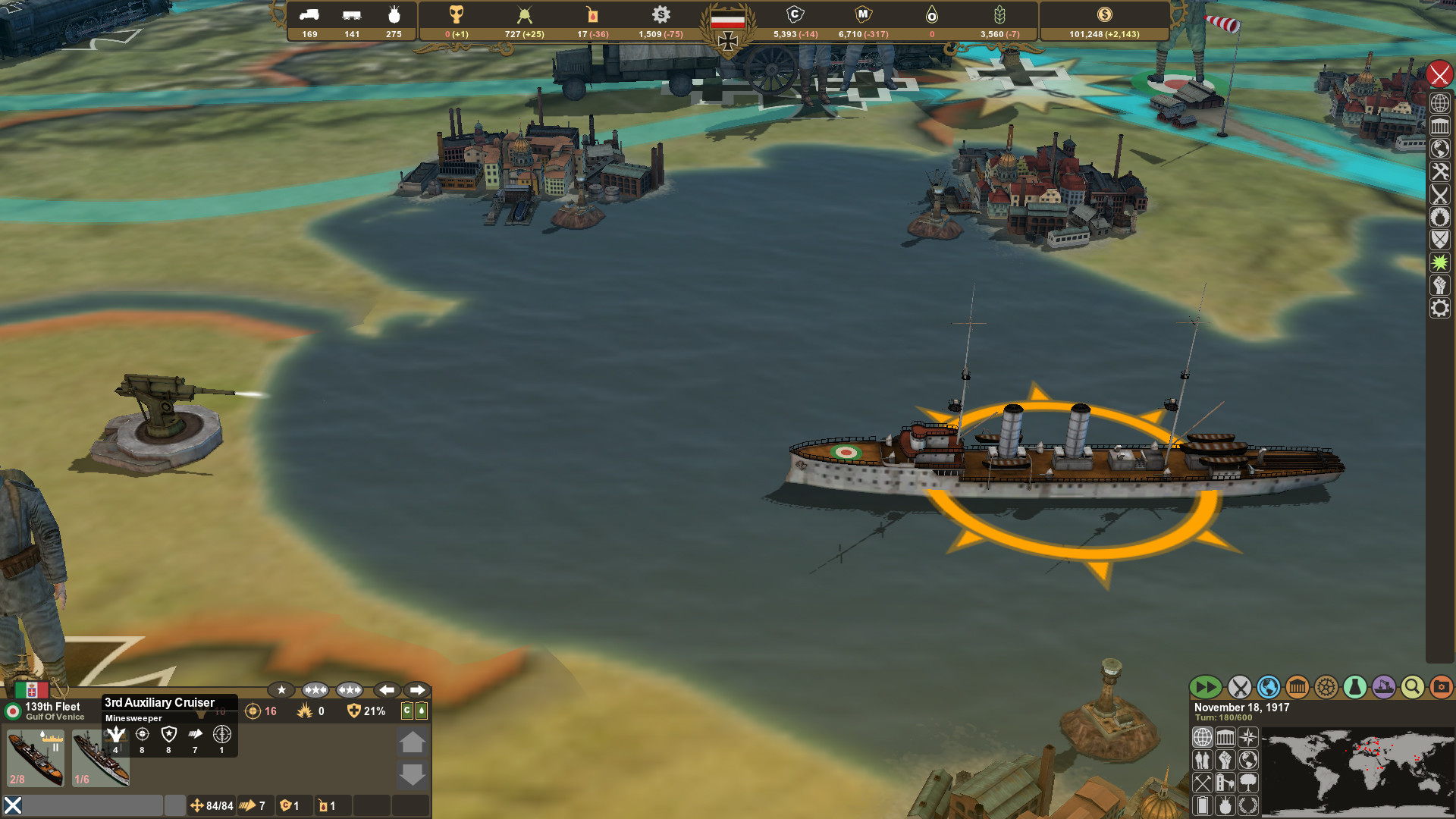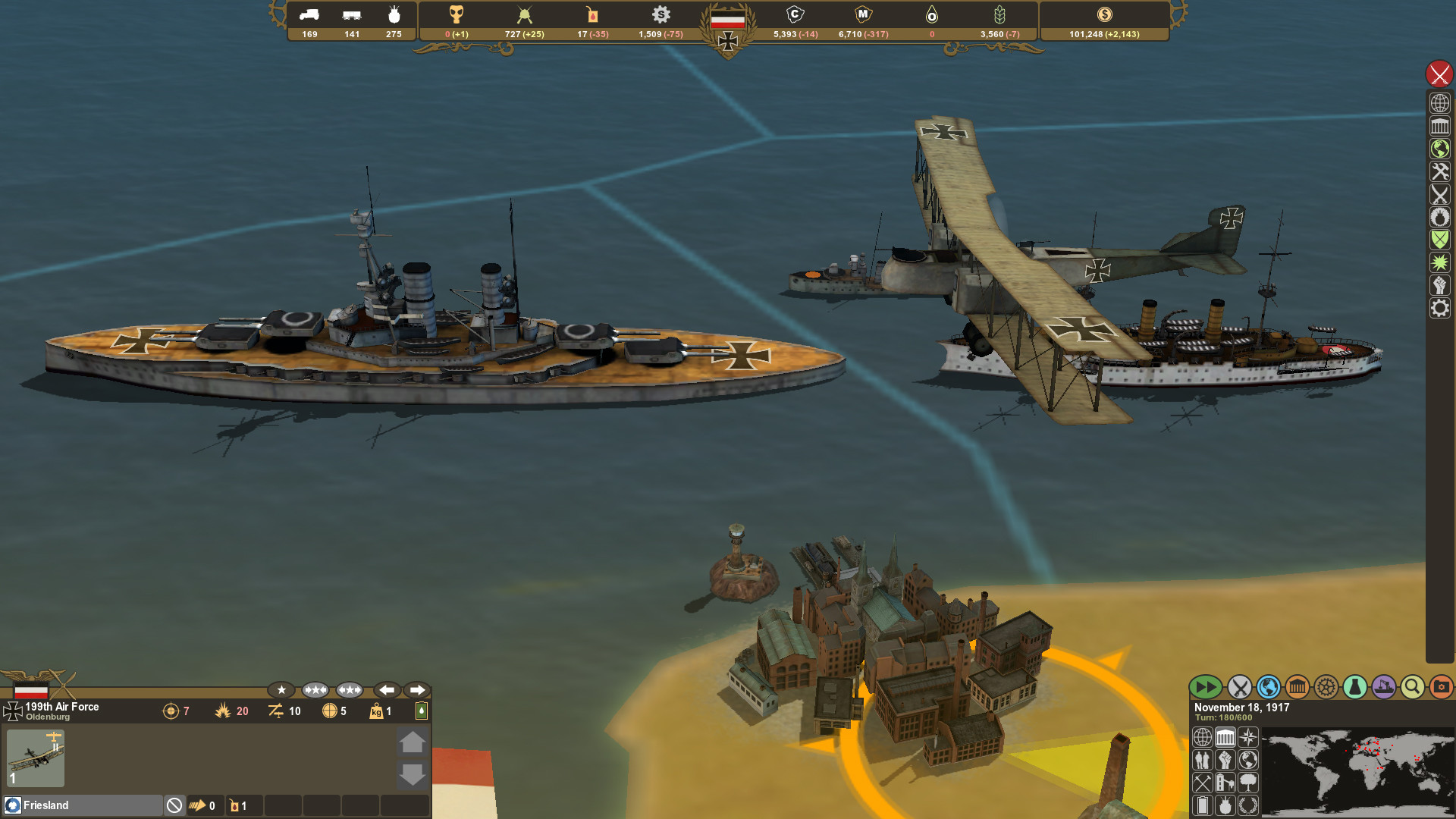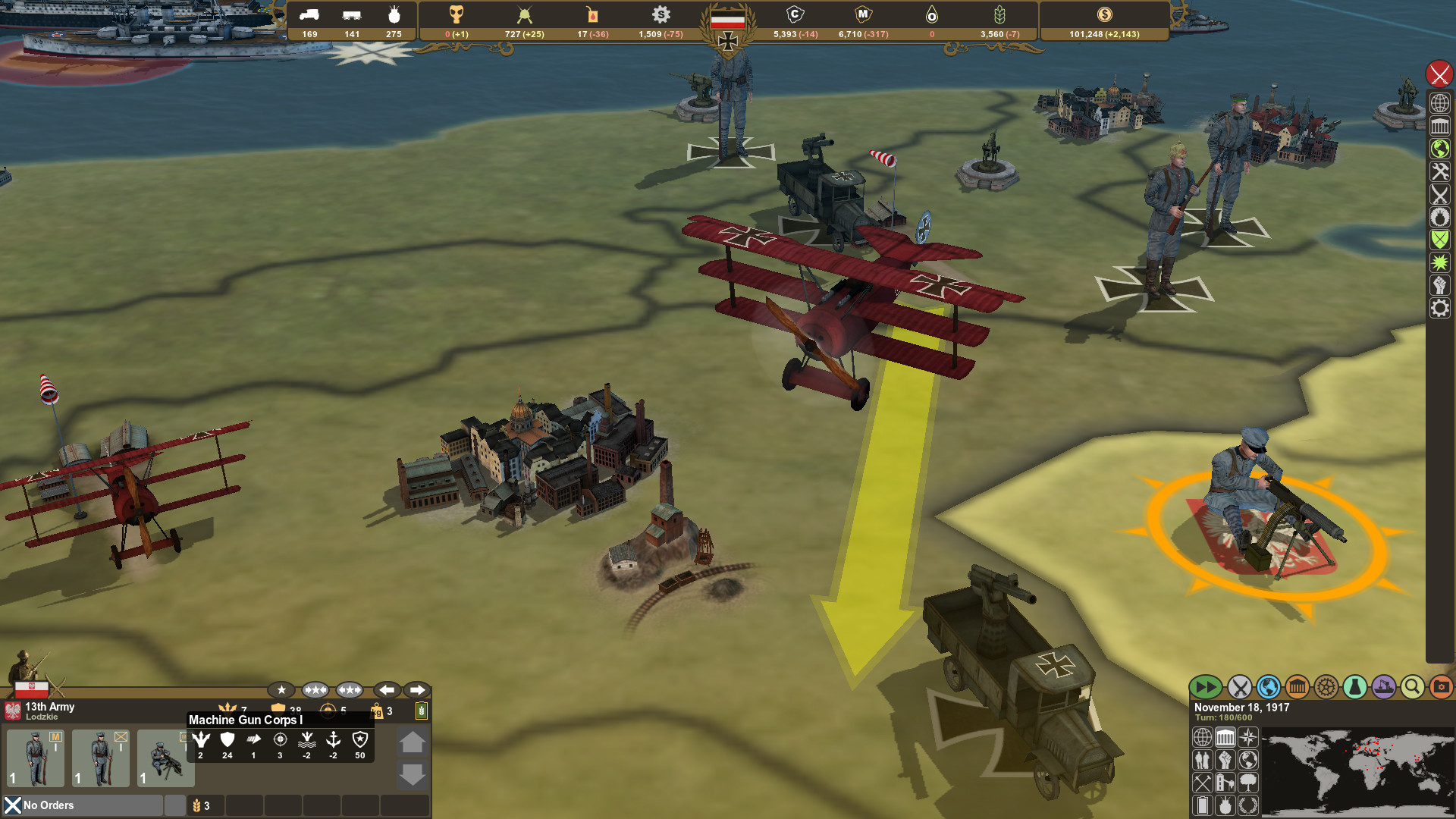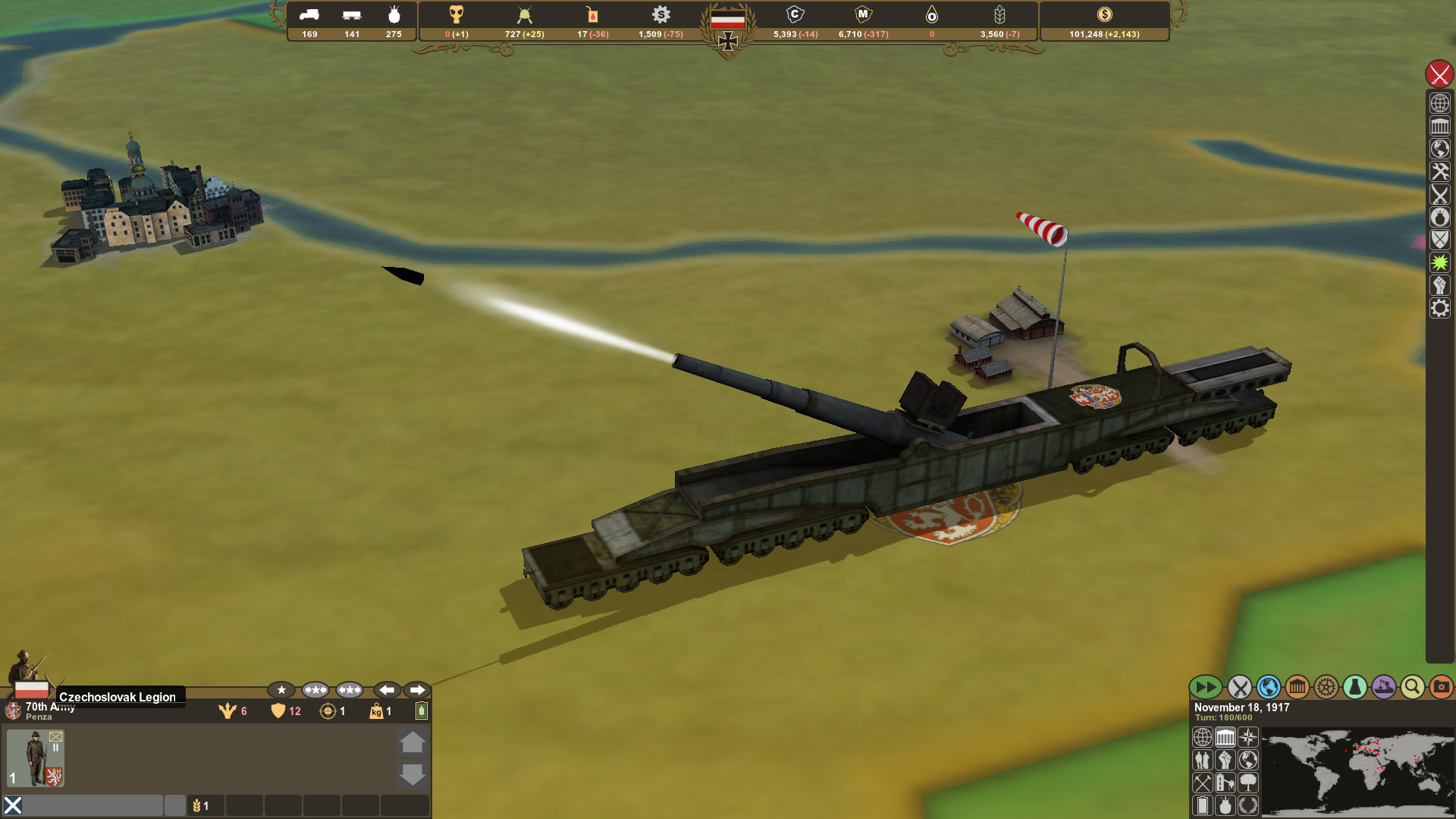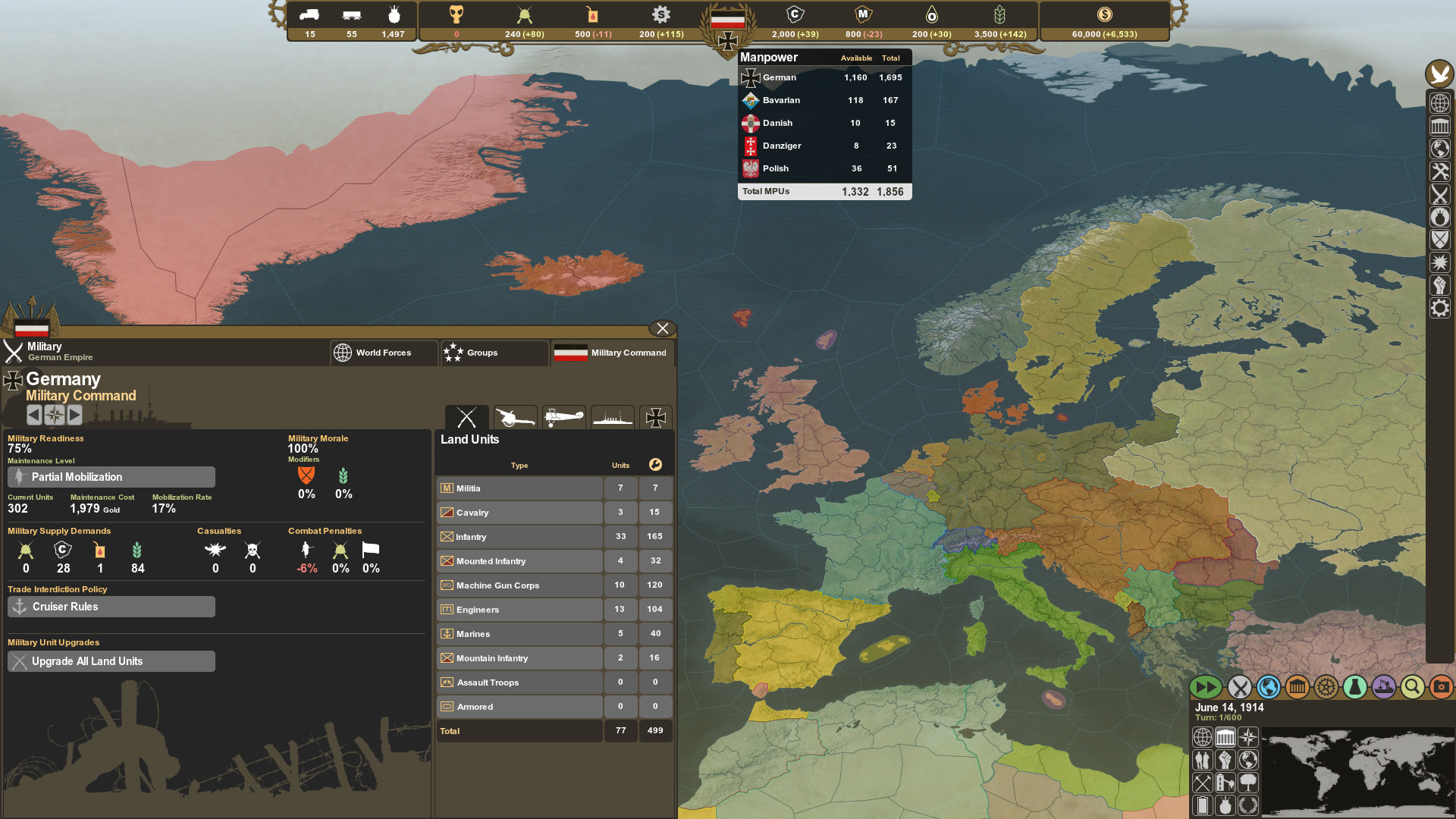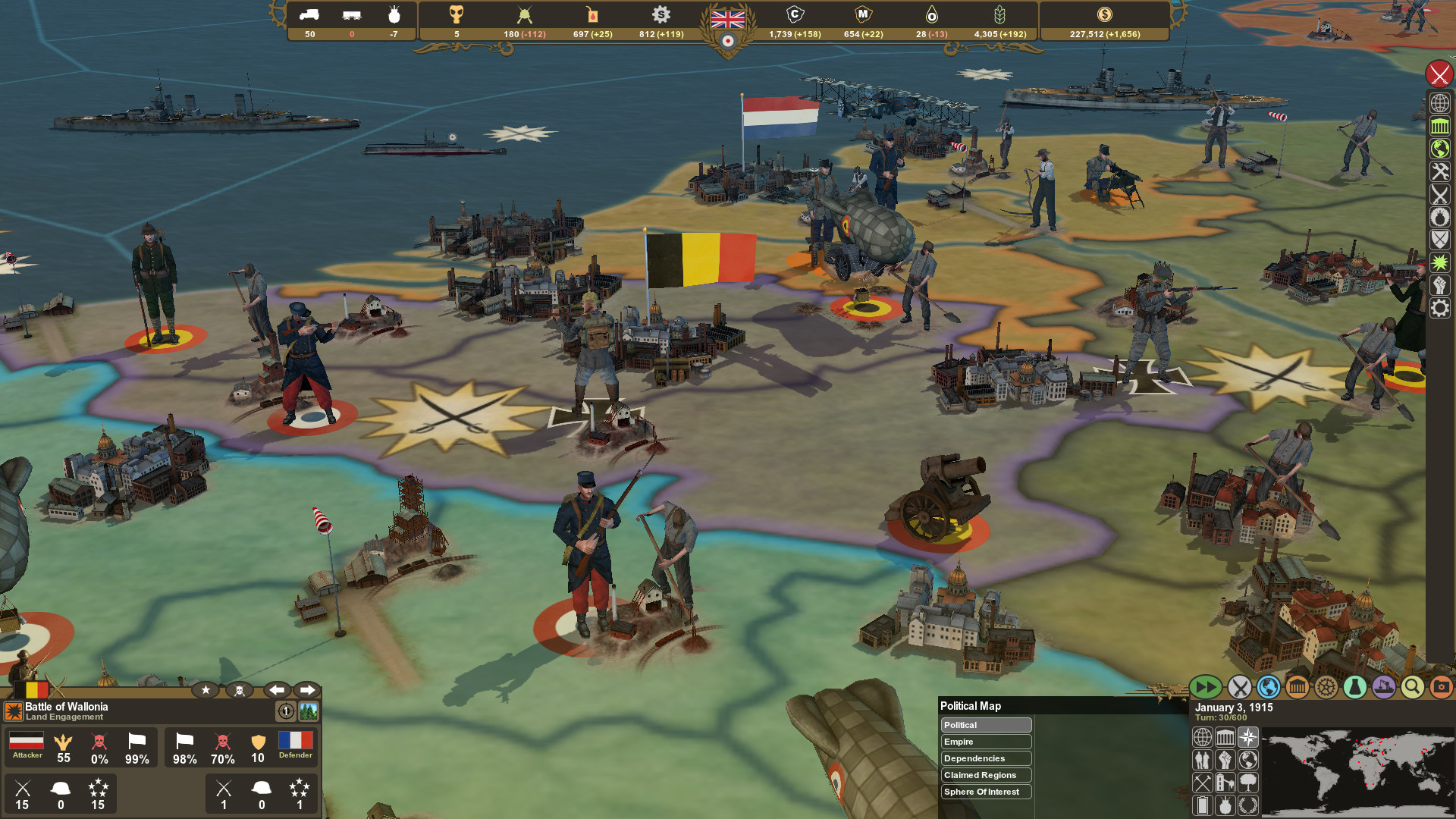
Covering one of the most catastrophic events in human history, Making History: The First World War offers a strategic level experience in a turn-based global game of conflict. It’s a war between the Great Powers of the age, each straddling to one degree or another, the old world and the new.
This is the moment when the industrialization of warfare became fully realized and the Great Powers mobilized their entire nations for total war. The introduction of new weapons with massive destructive power driven by machine era technology and mass production led to the death of many millions and the collapse of several storied empires.
Making History: The First World War is a game of conquest and economic management. Players make all the governing decisions for their nation. Historic events are there to direct the game along a WWI timeline providing the historical context and drama associated with the era. However as with any Making History game, it’s players who make history and create brand new worlds.
As the leader of France, fight to survive the continental ambitions of the German Empire. Play Germany and instigate Russian social unrest that might knock them out of the war early. Can you keep the Ottoman Empire from being partitioned? Will simmering ethnic nationalism cause Austria-Hungary to collapse and usher forth new nations in Central Europe? Use the most powerful navy on earth to maintain your vast colonial empire as the leader of the United Kingdom. Each nation you choose to play comes with a different set of strategic challenges.

Strategic Level Gameplay
The game map is divided up into over 2000 land and water regions covering all the continents and seas. Play as any independent nation of the WWI era and control your nation’s economy, military and domestic policies.
Empire Management
Govern and establish colonies, protectorates and puppet states. Liberate and give independence to conquered nations.
Infrastructure Expansion
Prospect, expand and exploit the strategic resources needed to feed an industrialized economy. Build railroads to move commodities and speed the movement of troops to the frontlines. Construct Fortresses, Trenches and Coastal Batteries to defend your nation from attack.
City Development
Your cities are key industrial assets that can simultaneously produce multiple output types. They generate wealth for your government, supplies for your people and steel for your military. Order your city to establish new factories, centers of research and health and a variety of manufacturing facilities.
Mobilization
Prepare for war by training manpower resources in times of peace. Mobilize your trained reserves at the right moment to get an advantage on your enemies. When the fighting ends, demobilize your units to a lower strength allowing manpower to return to work.

World War I Combat
Bombard your enemies from afar, then invade with Infantry and armor. Use observation balloons and aircraft to increase artillery accuracy. Deploy submarines and naval mines to sink and harass the enemies navy. Dig deep trench networks and defend your ground with machine gun units.
Regional Demographics
Each region has a defined identity representing nationality, culture, religion and multiple ethnicities. Governing support is tied to policies and the ideology of the population. High levels of radicalism can lead to unrest and revolutions.
Global Trade
Use the World Market to trade for needed supplies and sell your commodities to increase your income. Initiate a policy of Unrestricted Submarine Warfare against your enemies trade paths to interdict and sink their merchant fleets.
Historical Events
Hundreds of scripted events associated with the important moments and events during the war. Alternative historical paths are also covered that allow players to explore many what-if outcomes.
Technology Race
Expand your nation’s knowledge in Science, industry and military production skills with a detailed Research Tree spanning Pre-Industrial to Machine Age technology.
Diplomacy
Establish relations with new nations, provide financial aid and sign treaties to increase your diplomatic influence.
National Units
Each nation has a unique set of units that closely represent the uniforms and equipment of in the first decades of the 20th century.

Making History: The First World War
At the onset of WWI, almost all industrialized nations, even small ones, had compulsory military conscription laws. The United Kingdom and the United States were rare exceptions. Germanys system was very advanced and infamously detailed. The mobilization feature is meant to simulate differences between a heavily militarized nation like Germany and nations unprepared for a national war effort like the United States was at that time. Both have massive potential but one can field troops fast due to policy decisions and infrastructure investments. Size matters, but in this case much less than structural quality.

Mobilization can speed up the positioning of unit groups along the front but the total process will take several turns to bring these new forces to full strength. Each unit will begin with reduced manpower and a lower strength value. This represents the condition of lightly trained recruits and the overall organizational challenge. These starter units will begin increasing in manpower and strength each successive turn using the reinforcement system.

There are 3 main inputs to determine the maximum number of units a nation can mass mobilize: available manpower, infrastructure and conscription policy. By multiplying these three properties, we calculate the amount of Trained Reserves. The UI provides a slider that allows players to adjust the mobilization level. A single Trained Reserve will form a separate unit group.
Each recruitment facility adds to a capacity factor and indicates the type of unit that it will produce. More Barracks mean more trained manpower. And cities containing infrastructure that only recruit Militia will produce Militia units. The unit level will always be at the highest quality available to the recruiting nation based on the recruitment building.
Another key modifier is transportation infrastructure. Historically, road and rail development contributed to the speed and efficiency of advanced mobilization systems. This factor is important to both mobilization and the pace at which Military Readiness increases - more on that below. Also since your mobilized units are formed at bases distributed nationwide, railways will be the fastest method to get these units to the front.
A nation like Russia in 1914 has a lot of rail but many regions - at least half lacking any transportation infrastructure. This lowers their infrastructure modifier and ultimately decreases the number of Trained Reserves. Russia and even the United States have greater manpower than Germany but the latter has invested in the infrastructure and policies that maximizes their mobilization potential.
Its important to note that the mobilization feature does not inhibit or restrict the normal recruitment system. Penalties associated with mass mobilization are solely associated with the specific feature.
The last major factor is policy. At the moment, we have designed the national conscription policy to use the research system. Nations that have no policy will not be able to use the mobilization feature. This will likely be just a few small nations like Costa Rica. Even the lesser advanced nations should have the ability to raise militia forces. Mobilization is also not available to non-Independent nations although this feature could easily be extended to dependents. We will have to see what makes sense once more testing is done.
The mobilization system has a lot of underlying complexity and this places certain limits on flexibility. Specialty units like Engineers and Mountain Infantry, Armor and other hardware types will not be mobilized as part of this feature - just regular Infantry and Militia. Additionally, players will not have tactical choices as to where specific units are raised and from which regions the manpower is recruited from.

These are considered gameplay constraints. Units will only form in cities with recruitment centers and the manpower will be drawn randomly from all available regions based as best we can on nationality. Essentially, your mobilization results should reflect your existing infrastructure. If you build a recruitment facility in Hawaii, there is a chance to mobilize forces there however it is not a guarantee.
Military Readiness is a separate but essential aspect to both the mobilization system and to unit combat strength. In this case, a nation can only order a mass mobilization if they have set their national Military Readiness to General Mobilization. This action communicates to all nations to respond in kind if they feel threatened. A nation will not be able to hide a mass mobilization order.

Setting readiness to General Mobilization does not begin actual mobilization. This is a separate property representing the current investment in military readiness of your forces. If a nation has Low Readiness and then sets their readiness to General Mobilization - the highest level, the mobilization button will become active. Once the mobilization order has been given, the forces will deploy when Military Readiness has reached 100%.
After a nation has completed mobilization, then Demobilization is possible. Demobilization is a reverse process of the mobilization system. All units that require MPUs will have their manpower reduced to 1 and reinforcements turned off. At the Unit Group level, groups set to mobilize will receive reinforcements and demobilized groups will not. Demobilized manpower is distributed to regions using a similar method that mobilization employs.
The game will allow the player to mobilize or demobilize an army group individually as they see fit. There are currently limitations to when mass mobilizations can be ordered. At present, mass demobilization is not available if a nation is at war. Since the system is new, the game rules could still be adjusted and features extended.
While there is a significant amount to say about strategies and how the AI interprets mobilization, we will save this topic for a future post. One of our projects for this release will be to offer a decent manual to describe gameplay features to new and even existing players to the Making History games. I plan to create more posts and include content created for the manual.
On another front, a dedicated Making History community member has created a Discord server called the Making History: Official Discord. The goal is to have a location beyond Steam where fans of the gaming series can associate and organize MP games. It was just put up a few days ago and Factus Games plans to maintain a presence to help support and build the base. Please consider becoming a member. https://discord.gg/Aqw8nZt

Mass Mobilization
Weve just completed a new feature selected from our wish list of items weve wanted to add to Making History: The First World War. It involves the mobilization of national armies and the seemingly unstoppable momentum towards war. Since the mobilization decisions are so critical to the historical analysis of the conflict, we felt the gameplay should reflect that . With the mass mobilization order, a nation can quickly form a potentially large number of Infantry units in a fast as of 1 turn. This post will focus on how the system functions rather than the gameplay implications associated when using mobilization.At the onset of WWI, almost all industrialized nations, even small ones, had compulsory military conscription laws. The United Kingdom and the United States were rare exceptions. Germanys system was very advanced and infamously detailed. The mobilization feature is meant to simulate differences between a heavily militarized nation like Germany and nations unprepared for a national war effort like the United States was at that time. Both have massive potential but one can field troops fast due to policy decisions and infrastructure investments. Size matters, but in this case much less than structural quality.

Mobilization can speed up the positioning of unit groups along the front but the total process will take several turns to bring these new forces to full strength. Each unit will begin with reduced manpower and a lower strength value. This represents the condition of lightly trained recruits and the overall organizational challenge. These starter units will begin increasing in manpower and strength each successive turn using the reinforcement system.

There are 3 main inputs to determine the maximum number of units a nation can mass mobilize: available manpower, infrastructure and conscription policy. By multiplying these three properties, we calculate the amount of Trained Reserves. The UI provides a slider that allows players to adjust the mobilization level. A single Trained Reserve will form a separate unit group.
Each recruitment facility adds to a capacity factor and indicates the type of unit that it will produce. More Barracks mean more trained manpower. And cities containing infrastructure that only recruit Militia will produce Militia units. The unit level will always be at the highest quality available to the recruiting nation based on the recruitment building.
Another key modifier is transportation infrastructure. Historically, road and rail development contributed to the speed and efficiency of advanced mobilization systems. This factor is important to both mobilization and the pace at which Military Readiness increases - more on that below. Also since your mobilized units are formed at bases distributed nationwide, railways will be the fastest method to get these units to the front.
A nation like Russia in 1914 has a lot of rail but many regions - at least half lacking any transportation infrastructure. This lowers their infrastructure modifier and ultimately decreases the number of Trained Reserves. Russia and even the United States have greater manpower than Germany but the latter has invested in the infrastructure and policies that maximizes their mobilization potential.
Its important to note that the mobilization feature does not inhibit or restrict the normal recruitment system. Penalties associated with mass mobilization are solely associated with the specific feature.
The last major factor is policy. At the moment, we have designed the national conscription policy to use the research system. Nations that have no policy will not be able to use the mobilization feature. This will likely be just a few small nations like Costa Rica. Even the lesser advanced nations should have the ability to raise militia forces. Mobilization is also not available to non-Independent nations although this feature could easily be extended to dependents. We will have to see what makes sense once more testing is done.
The mobilization system has a lot of underlying complexity and this places certain limits on flexibility. Specialty units like Engineers and Mountain Infantry, Armor and other hardware types will not be mobilized as part of this feature - just regular Infantry and Militia. Additionally, players will not have tactical choices as to where specific units are raised and from which regions the manpower is recruited from.

These are considered gameplay constraints. Units will only form in cities with recruitment centers and the manpower will be drawn randomly from all available regions based as best we can on nationality. Essentially, your mobilization results should reflect your existing infrastructure. If you build a recruitment facility in Hawaii, there is a chance to mobilize forces there however it is not a guarantee.
Military Readiness is a separate but essential aspect to both the mobilization system and to unit combat strength. In this case, a nation can only order a mass mobilization if they have set their national Military Readiness to General Mobilization. This action communicates to all nations to respond in kind if they feel threatened. A nation will not be able to hide a mass mobilization order.

Setting readiness to General Mobilization does not begin actual mobilization. This is a separate property representing the current investment in military readiness of your forces. If a nation has Low Readiness and then sets their readiness to General Mobilization - the highest level, the mobilization button will become active. Once the mobilization order has been given, the forces will deploy when Military Readiness has reached 100%.
After a nation has completed mobilization, then Demobilization is possible. Demobilization is a reverse process of the mobilization system. All units that require MPUs will have their manpower reduced to 1 and reinforcements turned off. At the Unit Group level, groups set to mobilize will receive reinforcements and demobilized groups will not. Demobilized manpower is distributed to regions using a similar method that mobilization employs.
The game will allow the player to mobilize or demobilize an army group individually as they see fit. There are currently limitations to when mass mobilizations can be ordered. At present, mass demobilization is not available if a nation is at war. Since the system is new, the game rules could still be adjusted and features extended.
While there is a significant amount to say about strategies and how the AI interprets mobilization, we will save this topic for a future post. One of our projects for this release will be to offer a decent manual to describe gameplay features to new and even existing players to the Making History games. I plan to create more posts and include content created for the manual.
On another front, a dedicated Making History community member has created a Discord server called the Making History: Official Discord. The goal is to have a location beyond Steam where fans of the gaming series can associate and organize MP games. It was just put up a few days ago and Factus Games plans to maintain a presence to help support and build the base. Please consider becoming a member. https://discord.gg/Aqw8nZt
[ 2020-05-24 00:09:06 CET ] [Original Post]
Minimum Setup
- OS: Ubuntu 12.04 or later
- Processor: Intel Core2 Duo 2.4Ghz or Higher / AMD 3Ghz or HigherMemory: 4 GB RAMStorage: 1 GB available space
- Memory: 4 GB RAMStorage: 1 GB available space
- Storage: 1 GB available space
GAMEBILLET
[ 6425 ]
GAMERSGATE
[ 3675 ]
MacGamestore
[ 2899 ]
FANATICAL BUNDLES
HUMBLE BUNDLES
by buying games/dlcs from affiliate links you are supporting tuxDB

